Effect of Boron Content and Cooling Rate on the Microstructure and Boride Formation of β-Solidifying γ-TiAl TNM Alloy
Abstract
1. Introduction
1.1. Solidification Pathway
1.2. Effect of Boron
- (1)
- Blocky borides (B27) provide nucleation points for the α-phase and are not detrimental to the elastic limit. In addition, they are beneficial for refining the microstructure. They are associated with slow cooling rates during solidification and no segregations;
- (2)
- Ribbon borides (Bf) are detrimental because they do not help to nucleate the α-phase and reduce the elastic limit. This is due to the large β-boride interface, which may act as a crack initiation point. They are associated with high cooling rates during solidification.
1.3. Research Goal
2. Materials and Methods
2.1. Alloy Manufacturing and Melting Procedure
2.2. DSC and SEM Analysis
3. Results
3.1. Effect of Chemical Composition
3.1.1. Surface of the 2 mm Step (Fast Cooling)
3.1.2. Interior of the 16 mm Step (Slow Cooling)
3.2. Effect of the Cooling Rate
4. Discussion
4.1. Effect of the Chemical Composition
4.2. Effect of Cooling Rate
4.3. Boride Formation Mechanism
4.3.1. Ribbon Boride Formation Mechanism
- Zone 1:
- Movement of boron and aluminum towards the interior;
- Zone 2:
- Precipitation of ribbon borides once the solubility limit of boron and aluminum is reached;
- Zone 3:
- Progressive restoration of the nominal chemical composition;
4.3.2. Blocky Boride Formation Mechanism
5. Conclusions
- (1)
- Ribbon borides are formed under non-equilibrium conditions. They are precipitated even if the amount of boron is high enough to precipitate blocky borides when the cooling rate is too high. Ribbons are formed mainly inside segregations due to their rejection of aluminum. As a result, large lamellar colonies are formed with entangled ribbon borides, which are detrimental to mechanical properties;
- (2)
- When the boron content is above a critical value (for the modified TNM alloy, above 0.5 at.%) and the cooling rate during solidification is below 10 K/s, blocky borides are precipitated under equilibrium conditions;
- (3)
- Boron contents above the critical value and intermediate cooling rates are associated with the precipitation of a mixture of ribbon and blocky borides. The cooling rate during solidification seems to be more relevant than chemical composition to the precipitation of either ribbon or blocky borides. Therefore, in order to obtain a refined microstructure with no segregation, a cooling rate below 10 K/s and a boron content above the critical value must be ensured.
Author Contributions
Funding
Acknowledgments
Conflicts of Interest
References
- Appel, F.; Paul, J.; Oehring, M. Gamma Titanium Aluminide Alloys; Wiley: Weinheim, Germany, 2014. [Google Scholar]
- Kim, Y.W.; Kim, S.L. Advances in gammalloy materials-processes-application technology: Successes, dilemmas, and future. JOM 2018, 70, 553–560. [Google Scholar] [CrossRef]
- Habel, U.; Heutling, F.; Kunze, C.; Smarsly, W.; Das, G.; Clemens, H. Forged intermetallic γ-TiAl based alloy low pressure turbine blade in the geared turbofan. In Proceedings of the 13th World Conference on Titanium, San Diego, CA, USA, 16–20 August 2016; pp. 1223–1227. [Google Scholar]
- Clemens, H.; Wallgram, W.; Kremmer, S.; Güther, V.; Otto, A.; Bartels, A. Design of novel β-solidifying TiAl alloys with adjustable β/B2-phase fraction and excellent hot-workability. Adv. Eng. Mater. 2008, 10, 707–713. [Google Scholar] [CrossRef]
- Hecht, U.; Witusiewicz, V.; Drevermann, A.; Zollinger, J. Grain refinement by low boron additions in niobium-rich TiAl-based alloys. Intermetallics 2008, 16, 969–978. [Google Scholar] [CrossRef]
- Kastenhuber, M.; Klein, T.; Rashkova, B.; Weißensteiner, I.; Clemens, H.; Mayer, S. Phase transformations in a β-solidifying γ-TiAl based alloy during rapid solidification. Intermetallics 2017, 91, 100–109. [Google Scholar] [CrossRef]
- Cheng, T.T. Mechanism of grain refinement in TiAl alloys by boron addition-An alternative hypothesis. Intermetallics 2000, 8, 29–37. [Google Scholar] [CrossRef]
- Yang, C.; Jiang, H.; Hu, D.; Huang, A.; Dixon, M. Effect of boron concentration on phase transformation texture in as-solidified Ti44Al8Nb x B. Scr. Mater. 2012, 67, 85–88. [Google Scholar] [CrossRef]
- Kitkamthorn, U.; Zhang, L.C.; Aindow, M. The structure of ribbon borides in a Ti-44Al-4Nb-4Zr-1B alloy. Intermetallics 2006, 14, 759–769. [Google Scholar] [CrossRef]
- Hu, D. Role of boron in TiAl alloy development: A review. Rare Met. 2016, 35, 1–14. [Google Scholar] [CrossRef]
- Klein, T.; Clemens, H.; Mayer, S. Advancement of compositional and microstructural design of intermetallic γ-TiAl based alloys determined by atom probe tomography. Materials 2016, 9, 755. [Google Scholar] [CrossRef] [PubMed]
- Kartavykh, A.V.; Gorshenkov, M.V.; Podgorny, D.A. Grain re fi nement mechanism in advanced γ-TiAl boron-alloyed structural intermetallics: The direct observation. Mater. Lett. 2015, 142, 294–298. [Google Scholar] [CrossRef]
- Oehring, M.; Stark, A.; Paul, J.D.H.; Lippmann, T.; Pyczak, F. Microstructural refinement of boron-containing β-solidifying γ-titanium aluminide alloys through heat treatments in the β phase field. Intermetallics 2013, 32, 12–20. [Google Scholar] [CrossRef]
- Witusiewicz, V.T.; Bondar, A.A.; Hecht, U.; Zollinger, J.; Artyukh, L.V.; Velikanova, T.Y. The Al-B-Nb-Ti system. V. Thermodynamic description of the ternary system Al-B-Ti. J. Alloy. Compd. 2009, 474, 86–104. [Google Scholar] [CrossRef]
- Porter, D.A.; Easterling, K.E. Phase Transformations in Metals and Alloys; Springer-Science + Business Media, B.V.: Hong Kong, China, 1992. [Google Scholar]
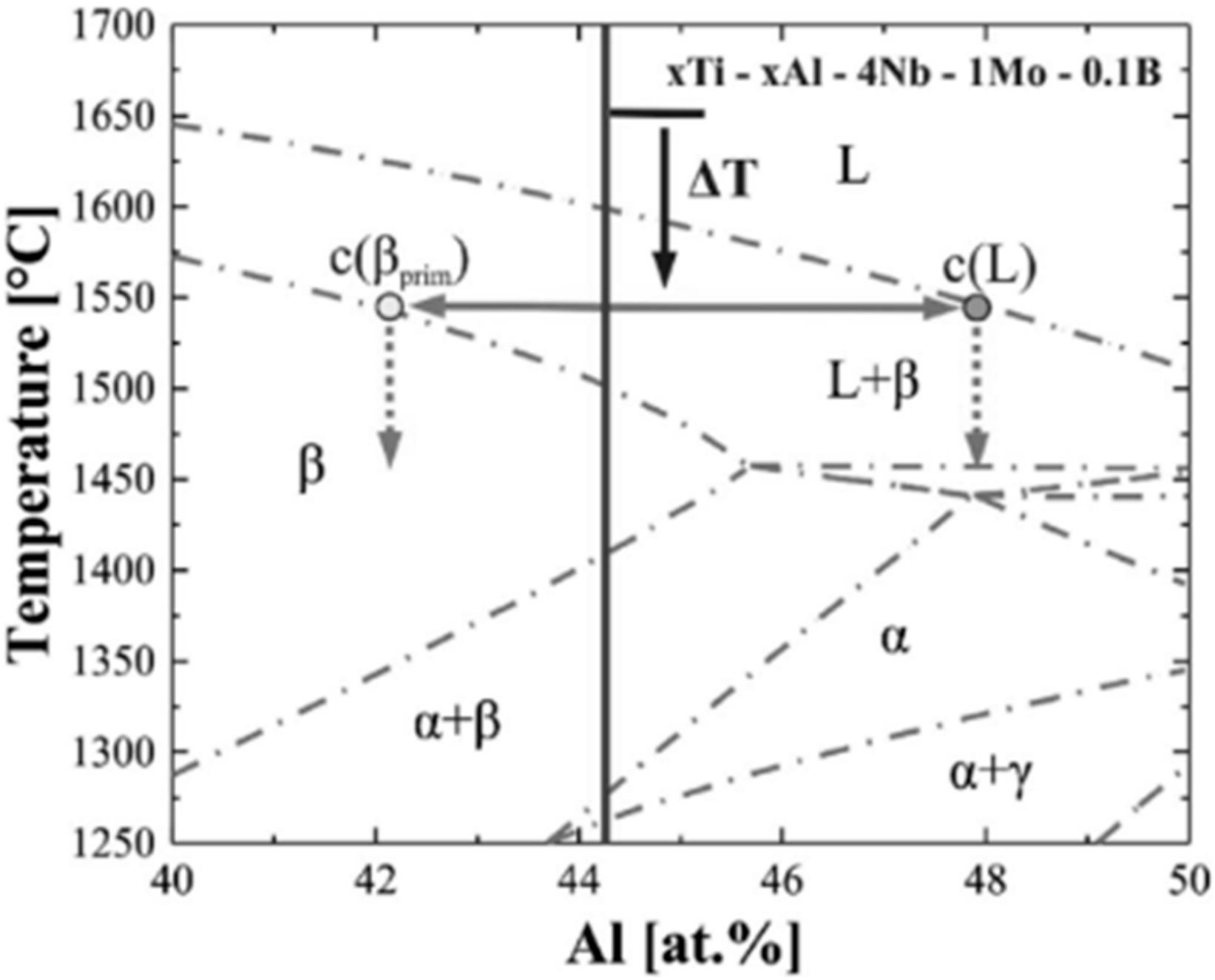
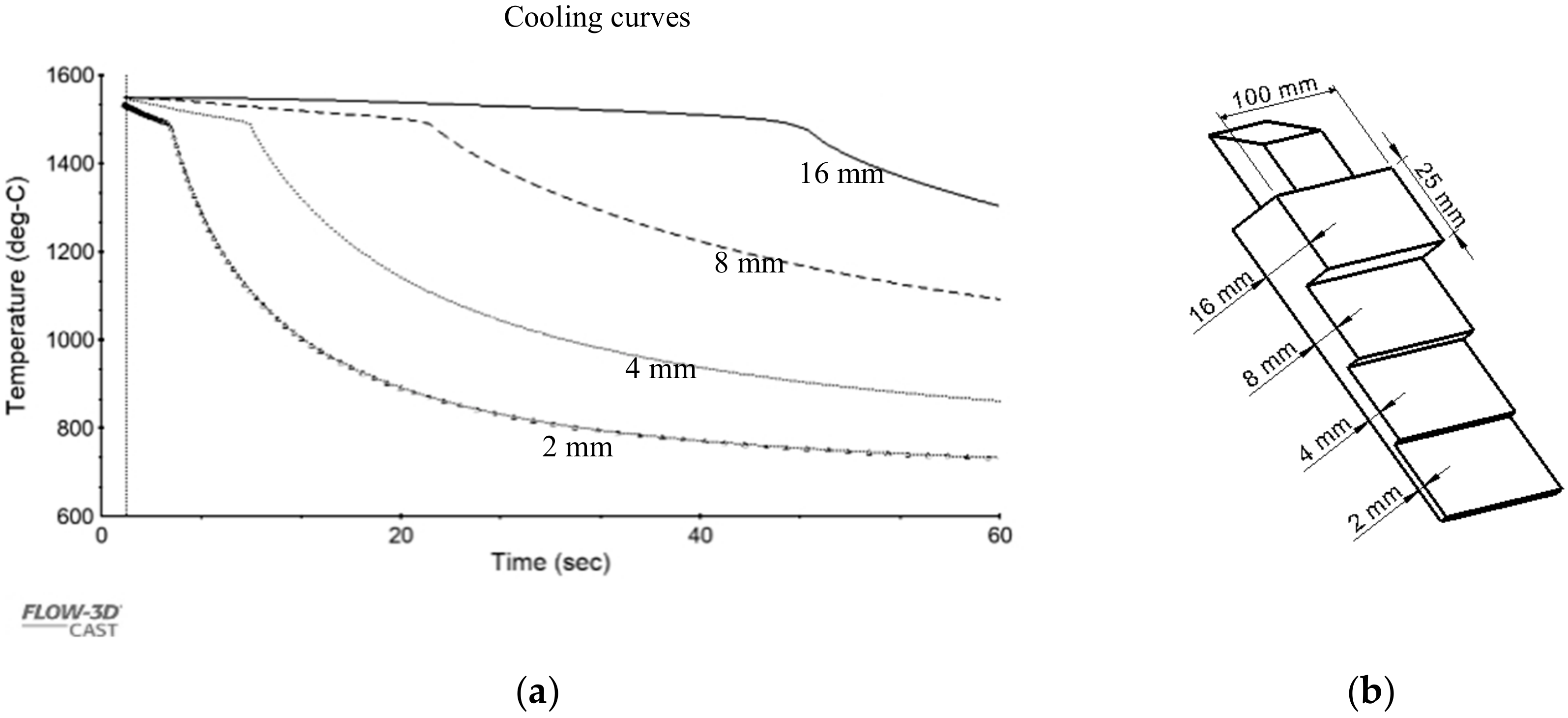
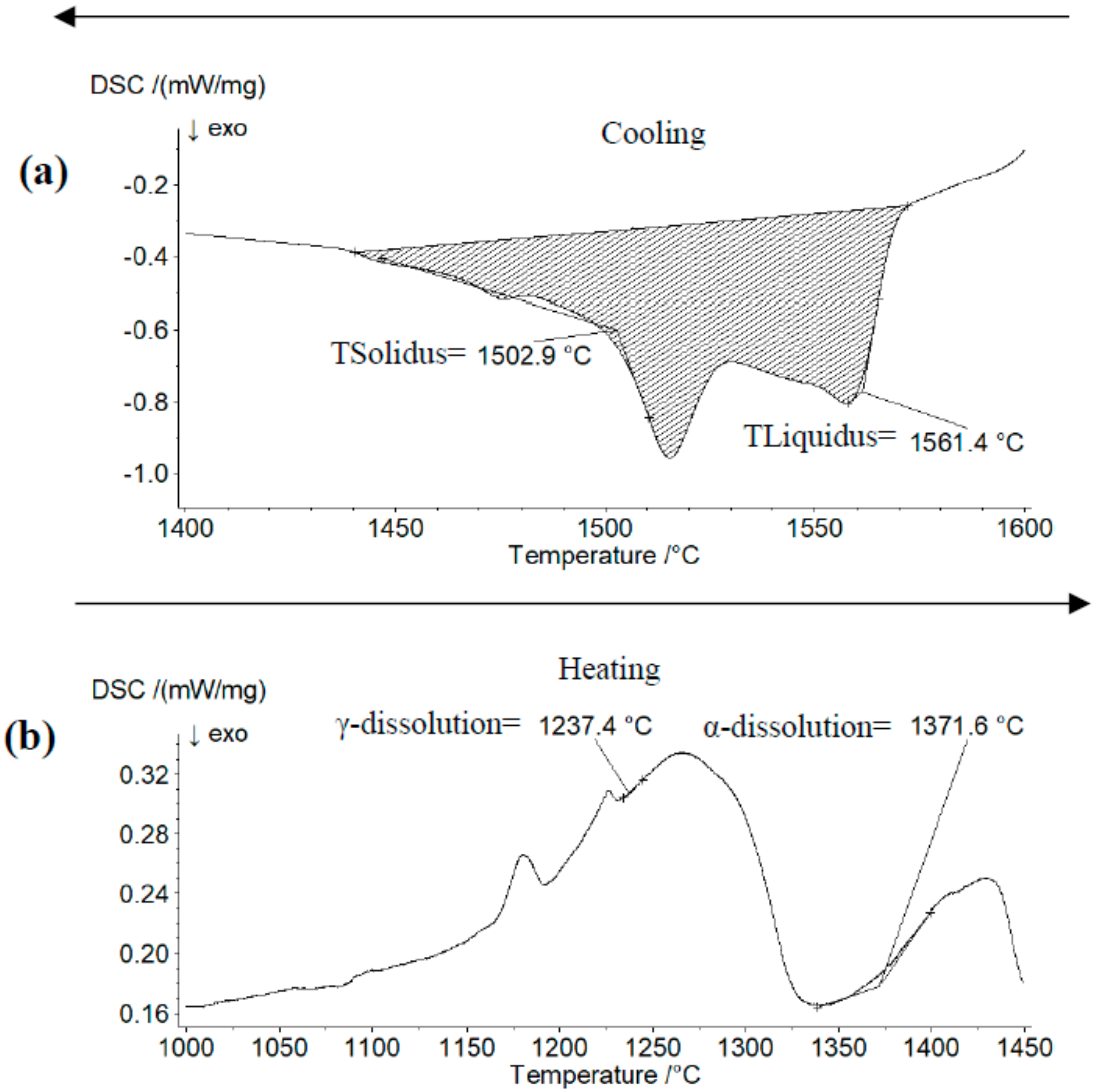
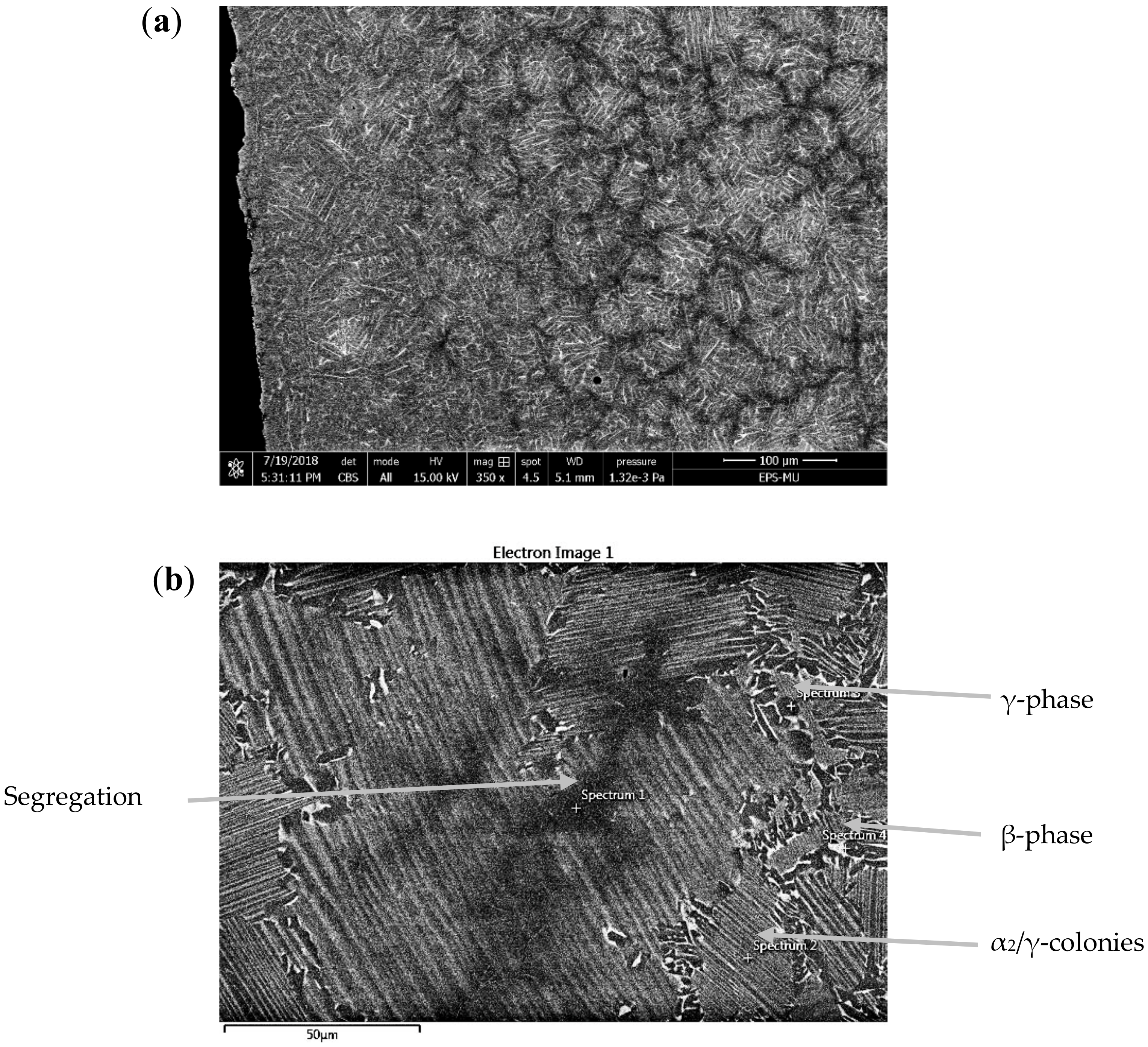
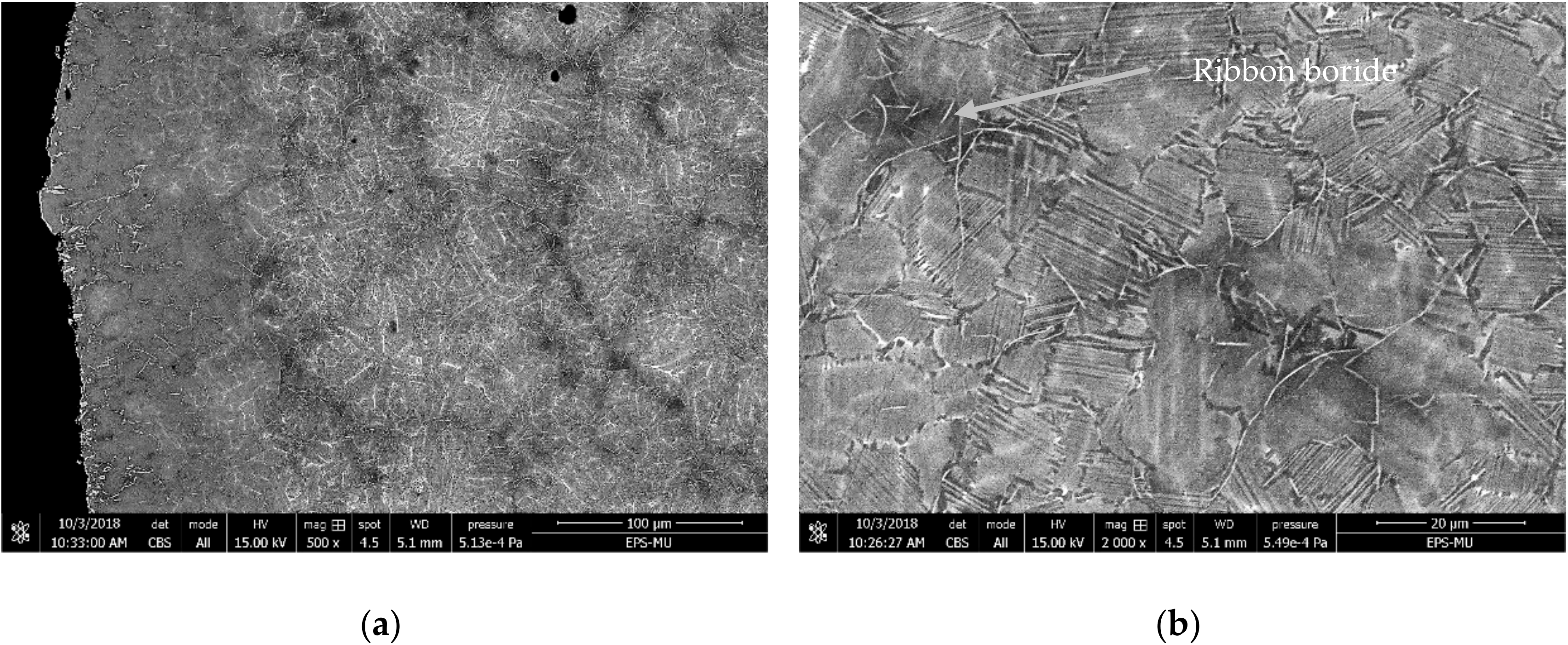
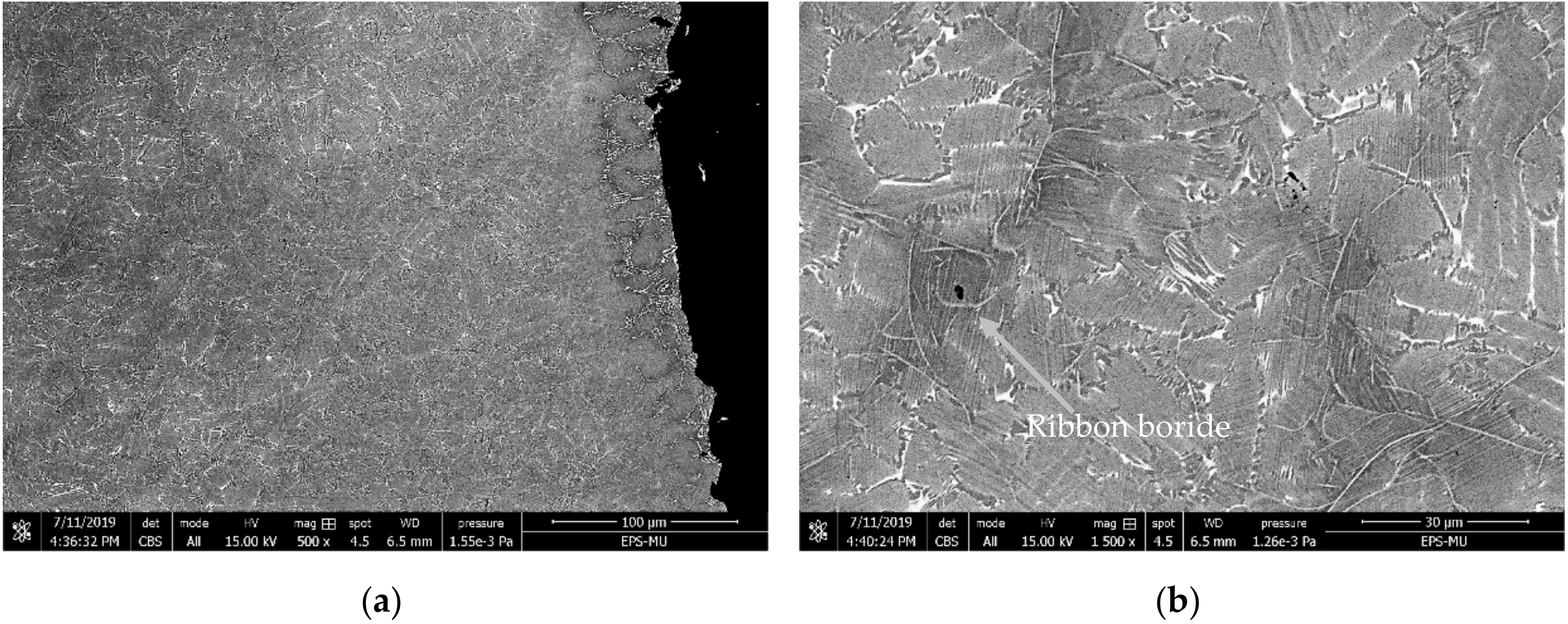
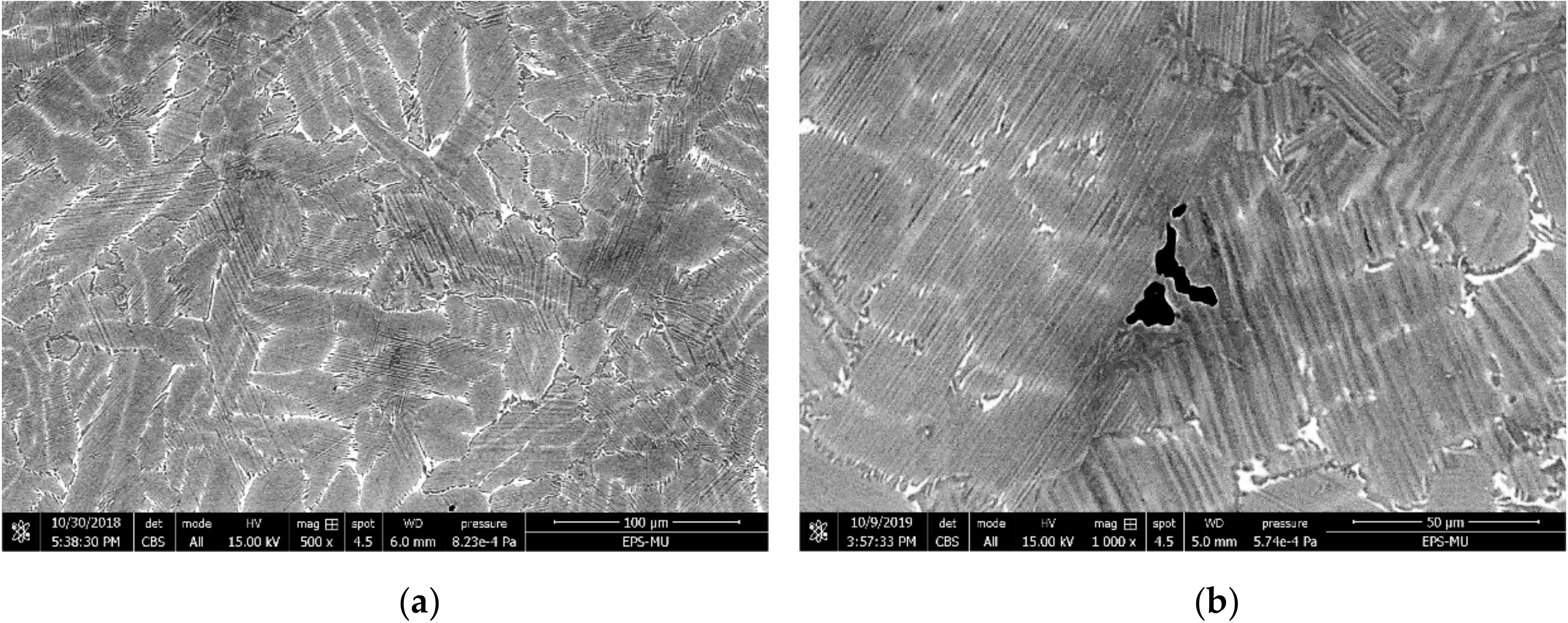
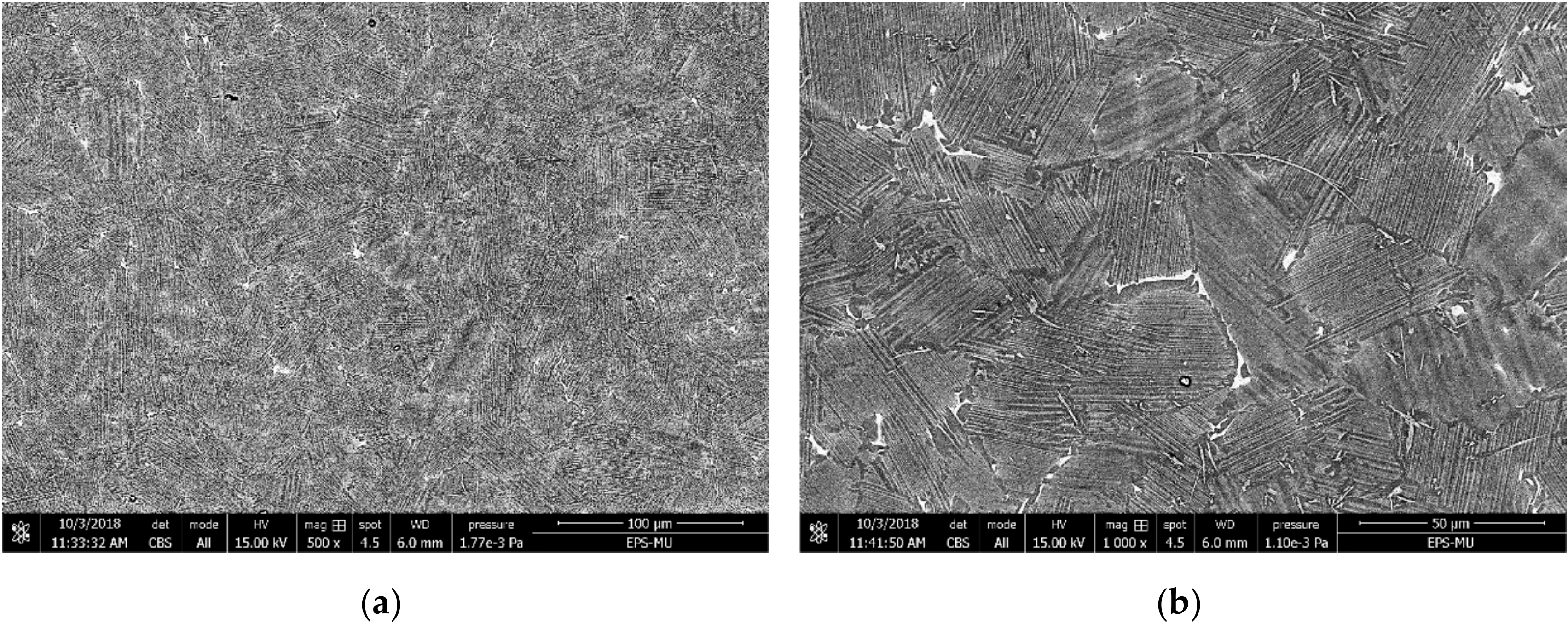
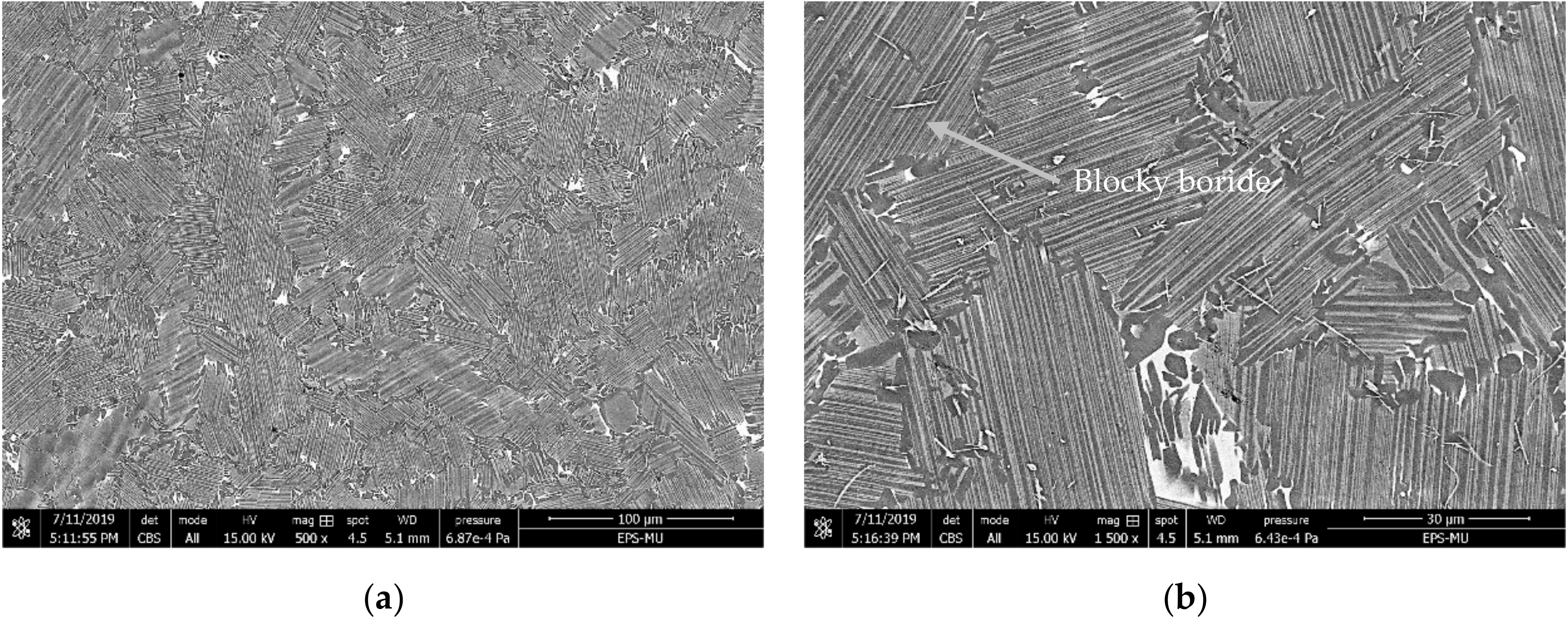
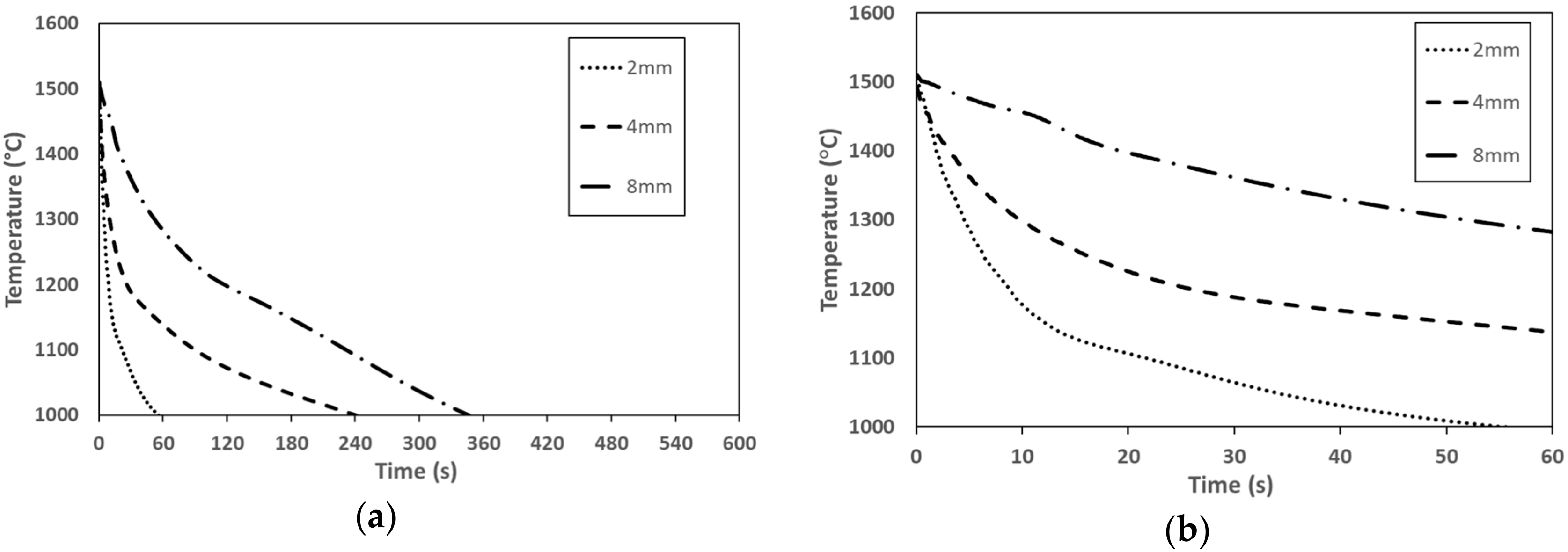

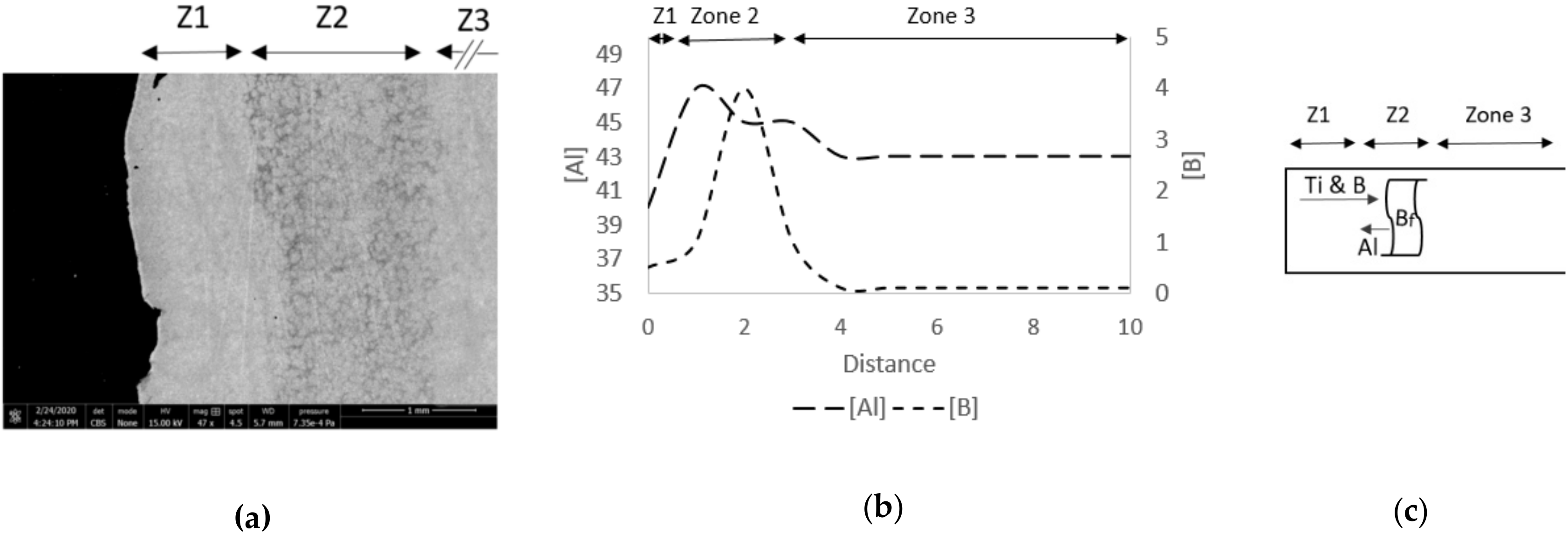
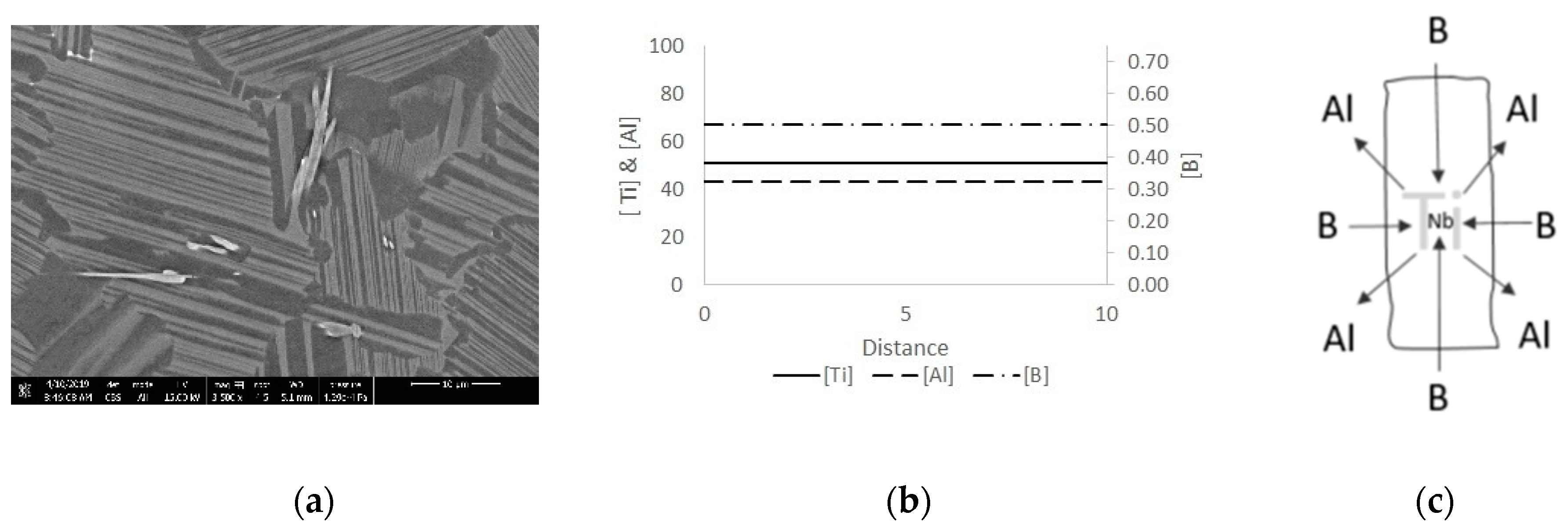
| Concentration (at.%) | Ti | Al | Nb | Mo | B |
|---|---|---|---|---|---|
| TNM-0.1B (master alloy) | 50.4 | 44.5 | 4 | 1 | 0.1 |
| TNM-0.6B | 50.1 | 44.6 | 3.6 | 0.9 | 0.6 |
| TNM-1.5B | 51.4 | 42.5 | 3.5 | 0.9 | 1.5 |
| Chemical Composition, at.% Spectrum | Ti | Al | Nb | Mo | |
|---|---|---|---|---|---|
| Phases | α2/γ-colonies | 51.7 | 43.3 | 4.2 | 0.9 |
| γ-phase | 50.3 | 45.0 | 4.1 | 0.6 | |
| β-phase | 55.8 | 36.2 | 5.2 | 2.8 | |
| Region | Segregation | 49.6 | 47.1 | 2.8 | 0.5 |
| Cooling Rate (K/s) | 2 mm | 4 mm | 8 mm | * 16 mm |
|---|---|---|---|---|
| Experimental, first 5 s after pouring | 43.8 | 25.6 | 6.8 | 2.3 |
| Alloy | TNM-0.1B | TNM-0.6B | TNM-1.5B | |
|---|---|---|---|---|
| Location | Surface of 2 mm step (fast cooling) | Many entangled ribbon borides and segregations | Randomly dispersed ribbon borides and segregations, with some blocky borides | Randomly dispersed ribbon borides and segregations, with some blocky borides |
| Inside 16 mm step (slow cooling) | Minor segregations with ribbons and few blocky borides | No segregations and mixture of ribbons and blocky borides | No segregations with many blocky and few ribbon borides | |
© 2020 by the authors. Licensee MDPI, Basel, Switzerland. This article is an open access article distributed under the terms and conditions of the Creative Commons Attribution (CC BY) license (http://creativecommons.org/licenses/by/4.0/).
Share and Cite
Bernal, D.; Chamorro, X.; Hurtado, I.; Madariaga, I. Effect of Boron Content and Cooling Rate on the Microstructure and Boride Formation of β-Solidifying γ-TiAl TNM Alloy. Metals 2020, 10, 698. https://doi.org/10.3390/met10050698
Bernal D, Chamorro X, Hurtado I, Madariaga I. Effect of Boron Content and Cooling Rate on the Microstructure and Boride Formation of β-Solidifying γ-TiAl TNM Alloy. Metals. 2020; 10(5):698. https://doi.org/10.3390/met10050698
Chicago/Turabian StyleBernal, Daniel, Xabier Chamorro, Iñaki Hurtado, and Iñaki Madariaga. 2020. "Effect of Boron Content and Cooling Rate on the Microstructure and Boride Formation of β-Solidifying γ-TiAl TNM Alloy" Metals 10, no. 5: 698. https://doi.org/10.3390/met10050698
APA StyleBernal, D., Chamorro, X., Hurtado, I., & Madariaga, I. (2020). Effect of Boron Content and Cooling Rate on the Microstructure and Boride Formation of β-Solidifying γ-TiAl TNM Alloy. Metals, 10(5), 698. https://doi.org/10.3390/met10050698





